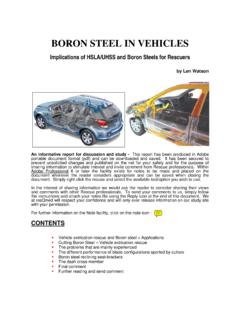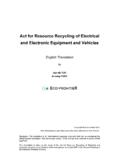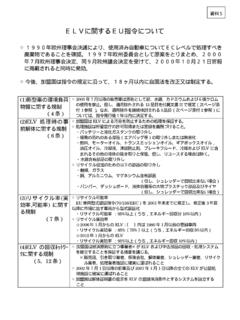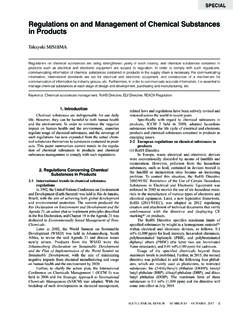Transcription of What all rescuers should know - res Q med
1 what all rescuers should know - Chemical propellant for airbags can kill ! Report by Len Watson Last updated 11/2010 An informative report for discussion and study - This report has been produced in Adobe portable document format (pdf) and can be downloaded and saved. It has been secured to prevent unsolicited changes and published on the net for your safety and the purpose of sharing information to stimulate interest and invite comment from rescue professionals. Within Adobe Reader 6 or later, the facility exists for notes to be made and placed on the document wherever the reader considers appropriate and can be saved when closing the document. Simply right click the mouse and select the available tool/option you wish to use. In the interest of sharing information we would ask the reader to consider sharing their views and comments with other rescue professionals.
2 To send, simply follow the instructions and attach your notes file using the Reply icon at the end of this document. We at resQmed will respect your confidence and will only ever release information on our study site with your permission. For further information on the Note facility, click on the note icon - Contents Sodium Azide (NaN3) airbag propellant is a growing health hazard and environmental problem Sodium Azide (overview) Rescue Implications Release of Sodium Azide End of life airbags End of life vehicle processing (Depollution) Security information Facts about sodium azide - what sodium azide is Technical information Right of reply References Further reading what all rescuers should know - Chemical propellant for airbags can kill ! Report by Len Watson Sodium Azide (NaN3) airbag propellant is a growing health hazard and environmental problem - Vehicle Airbags use a chemical compound that is so toxic that even small amounts can kill.
3 Yet tons and tons of Sodium Azide (NaN3) are routinely transported around the longitude and latitude of the world. Additionally scrapped airbags sit like environmental time bombs in the myriad of scrap yards that we see in most communities. On March 26, 2005 at a national meeting of the American Chemical Society in San Francisco, atmospheric scientist Eric A. Betterton (University of Arizona) said 'scientists really don't know where or how all this Sodium Azide will inevitably wreak greatest environmental havoc'. For several years now, both he and his undergraduates have been carrying out experiments to gain a greater understanding. Although Sodium Azide is already used in many industrial products, such as explosives, detonators, anticorrosion solutions, broad-spectrum biocides and airline safety chutes, with the advancement of passive vehicle safety systems a much larger threat to our environment has emerged over the last 15 years.
4 Betterton stated - "As the demand for airbags increases, and as vehicle fleets age over the next few decades, the amount of Sodium Azide that could potentially be released to the environment will greatly exceed the approximated 5 million kilograms (11 million pounds) that has already been incorporated into airbag inflators in the United States alone." "Given the huge surge in production, there exists a greatly increased potential for significant accidental spills and subsequent human and environmental exposure to this material." Sodium Azide Sodium Azide (NaN3) looks like common table salt but is every bit as powerful a poison as Sodium Cyanide. Even in minute amounts it can kill everything from bacteria and fungi to animals and humans. Ingesting or adsorbing as little as 50 milligrams (less than two-thousandths of an ounce) can cause the average adult to collapse into a coma-like state within five minutes.
5 Blood pressure will drop and the heart will become tachycardic. Ingest a few grams, and death can occur in as little as 30 minutes. Studies as far back as 1970 show that at 10 parts per million in the soil, Sodium Azide kills or degrades the seeds of many plants. Betterton noted that at 200 ppm, it not only sterilises the soil - but also changes soil chemistry, killing all soil bacteria and fungi. Little is known about the environmental effects of Sodium Azide. However what is known is that Sodium Azide is water-soluble. Betterton states that "Spills could possibly migrate into the water table via sewers, streams, lakes, and groundwater systems,". The compound when wet protonates volatile Hydrazoic Acid, a potential threat to rescuers , vehicle recovery agents and even sanitation workers and others that may come in contact with the Acid or Hydrazoic Acid gas. Betterton and his students tested how readily it oxidises when exposed to some environmental oxidants that may be found in water, such as Hydrogen Peroxide, an ingredient in natural rainwater, and ozone, a very powerful oxidant in the atmosphere.
6 Oxidisation is just one way Sodium Azide degrades in the environment. Betterton's studies also show that Sodium Azide combines readily with water to form Hydrazoic Acid. The "Henry's Law constant" for Hydrazoic Acid, or the ratio of how much Hydrazoic Acid that remains in solution and how much will be released as highly toxic Hydrazoic Acid gas into the atmosphere. The Henry's Law constant identifies that much more of the acid is released as gas into the atmosphere than remains in water. Rescue Implications - The wide use of Sodium Azide as a means of propellant to inflate airbags in passive restraint systems is readily accepted as the motor industry standard. Tiny tablets of Sodium azide are packed into a 50mm-diameter metal canister inside the airbag module. The driver-side airbag inflator holds about 50 grams of Sodium Azide. The passenger-side airbag inflator is about 150mm in diameter and holds in the region of 200 grams to inflate the larger front passenger bag.
7 Moreover and perhaps much more prevalent, seat airbags and seatbelt pretensioners can also contain Sodium Azide. This knowledge gives immediate recognition to the risk that rescuers face when performing certain extrication evolutions in releasing trapped vehicle occupants. Apart from the obvious risk of deploying undeployed systems as the wreckage is cut away, rescuers are also confronted with the possibility of inadvertent cutting through a module releasing Sodium Azide. The highest probability of this would appear to exist when removing the side of the vehicle. Cutting away the centre post complete with the rear door on the 4 door car usually necessitates cutting into the base of the centre post. To inadvertently cut through the pretensioner unit can liberate the Sodium Azide and powder the pellets in the process. This becomes more prevalent where a 'combi' tool is used to cut the base of the centre post.
8 Release of Sodium Azide - A similar situation also exists where the 1/4 panel on a 2 door car or coupe needs to be cut away to release a rear seat occupant. The hydraulic cutter has sufficient power to cut through the pretensioner's cartridge and, where it does not deploy under the cutting pressure, liberate its contents. Potentially this situation could be exacerbated if it were raining at the time or, if the powdered residue on the cutter's blades were to fall into open wounds or the dust inhaled on a windy day. Of course avoiding the pretensioner in the first place would appear to be the answer; but ' what if' still identifies a valid training need. 'Side removal' performed using a combi tool carries the highest risk of inadvertently cutting through the pretensioner module. We must also consider that in the process of extricating people from crashed vehicles rescuers will cut away doors, roofs and remove seats.
9 Some doors and seats which, on many occasions, will increasingly incorporate undeployed airbags; when removed will become a hazard putting investigating officers, recovery agents and reclaimed parts and scrap technicians at risk. This in time promises to become a serious situation generating thousands of door, seat and roof units year on year in the UK alone. End of life airbag Every airbag has a rated life expectancy in which it should perform as intended. Most manufacturers state 10 some state 15 years. As the module matures and its life cycle reached and exceeded, pellets will suffer from fatigue and crumble. The increased surface area of degraded propellant will give rise to faster ignition with much greater deployment force that can burst the airbag. With age the integrity of the hermetic container can fail. Sodium Azide is hydroscopic and atmospheric water vapour can leak through the inner foil and the squib seal and corrode contacts and the container itself, which in turn can leak Hydrozoic Acid.
10 End of life vehicle processing (Depollution). From the million End-of-Life Vehicles (ELV) in the UK each year, scrap yard technicians increasingly remove airbags and store them. Some are left in cars as they stand degrading in the lot. Some are crushed and the airbag canister can burst open, spilling Sodium Azide and generating dust or Hydrazoic Acid. Airbag storage is a problematic issue for many organisations. Any airbag store needs to meet a minimum specification and be licensed. The store must be securable, weatherproof and clearly labelled with the appropriate warning signs. A method of stock control / tracking of contents is also required. Licences are normally granted by the local Trading Standards Explosives Officer. Currently, it is illegal to attempt to dispose of live airbags in any UK landfill site. With a view to control the ELV a directive was passed into European law in October 2000 and was due to be transposed into national law in all Member States by 21 April 2002.







